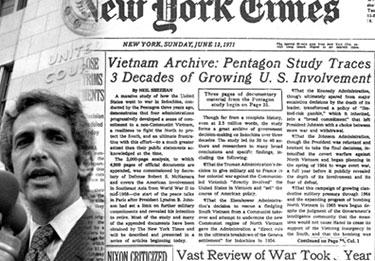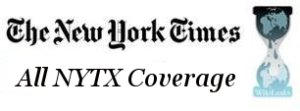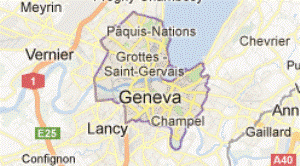NEW YORK
Fighting for the Press by James C. Goodale: “A First Look At The Pentagon Papers”
June 6, 2013 · 0 Comments

James C. Goodale was chief counsel for the New York Times during the Pentagon Papers case. He is also former vice chairman of the New York Times Co. and is a leading legal expert on the First Amendment.

Book Details:
Publisher: CUNY Journalism Press
Published: 2013
Paperback: 260 pages
Introduction to Book Excerpt
By Chris Spannos:
In his new book Fighting for the Press: The Inside Story of the Pentagon Papers and Other Battles, James C. Goodale gives his riveting insider account documenting one of the greatest battles for press freedom in U.S. history.
In June 1971 the New York Times began publishing the leaked Pentagon Papers - seven-thousand “Top-Secret” Defense Department documents bound in forty-seven volumes that exposed secret U.S. government wrongdoing in Vietnam.
As chief counsel for the Times, Goodale led the legal strategy defending the Times’s decision to publish the classified Papers against the Nixon administration’s attack on free speech.
In this exclusive NYT eXaminer excerpt of Fighting for the Press, chapter IX “A First Look at the Pentagon Papers,” Goodale describes his own attitude towards publishing the Papers. He touches briefly upon court decisions that were fundamental for press freedoms and that influenced his strategy to publish.
One of those decisions, the landmark 1964 New York Times Co v. Sullivan Supreme Court case, ruled that public officials needed to prove actual malice in order to recover damages for libel.
Also before the Pentagon Papers case, the Nixon Administration sued Times reporter Earle Caldwell in 1970 for his notes for articles about The Black Panther Party. The case, United States v. Caldwell, had historic consequences -- such as shield laws that many states enacted -- for the protection of journalist’s sources.
In his book, Goodale opens up to talk about closed-door meetings with Neil Sheehan, the Times journalist who obtained the Pentagon Papers -- who wrote the Times’s famous series of articles on the Papers -- as well as Editor Abe Rosenthal. These closed meetings were held to discuss the consequences of publishing the “Top-Secret” information against the government’s wishes.
Aside from being chief counsel to the Times, Goodale was uniquely qualified to defend the paper against the Nixon administration’s attack. He explained that, of all the lawyers involved in the Pentagon Paper’s case, he was the only one with intelligence training.
When Goodale arrived at the New York Times in 1963 he had already been cleared for access to “secret” classified information since 1959. He had been a member of an elite intelligence unite in the Army Reserve called the Strategic Intelligence Research and Analysis Unit.
Goodale commented that while the U.S. system of classified information is supposed to protect the nation’s secrets, “it is a broken system because information is classified indiscriminately.” The Marine Corps classified its annual dinner menu “secret.” Similarly, while Goodale was an active member in the intelligence unite, he stamped reports “secret” that relied on principle open sources such as the New York Times. Goodale observed that this classification system leaks in some large part because “no one has much respect for the system.”
Fighting for the Press features a wide cast of characters. From the Times’s other legal counsel who advised against publishing the Pentagon Paper’s -- Art Hooker and Louis Loeb of the long defunct firm Lord, Day & Lord -- to then Times publisher Arthur Ochs “Punch” Sulzberger and vice chairman Harding Bancroft, who both worried about Nixon's response if they published. Goodale’s story charts the turbulent historical, legal, and enlightened path that led to publishing the Pentagon Papers, and -- ultimately -- to a victory for the First Amendment.
Today the Obama administration is attacking whistleblowers and publishers -- Bradley Manning, Julian Assange, WikiLeaks and others - as part of an attack on press freedoms more broadly. Those who report the news, as well as their sources, fear fulfilling the duties of the Fourth Estate to hold government accountable. Goodale’s book offers a strong and contagious dose of courage - which is needed to carry forward today’s fight for a free press. In this spirit, NYTX offers you chapter IX of Goodale’s book.
Chris Spannos
NYTX, Editor
Chapter IX: A First Look At The Pentagon Papers
By James C. Goodale
The next day, the Papers were wheeled into my office in several supermarket carts. They filled every nook and cranny. I reached for Volume One and I was surprised at what I had read. Immediately, I began to focus on ways to publish the Papers without legal risk.
My philosophy as a publishing lawyer was that anything could be published. I had always found that if you took a word out here and there, shifted a paragraph here and there, anything was possible. I developed this point of view over eight years of representing reporters and editors who were principally concerned about libel.
In 1964, a year after I arrived at the Times, the Supreme Court decided the Sullivan case. Sullivan had won a half-million dollar verdict against the Times. The Times then was making little money and payment of this verdict, along with other million-dollar claims pending at the same time, would have bankrupted it. The Times appealed to the Supreme Court and won.
Reporters and editors were particularly eager to have me check what they wrote so that they wouldn’t end up in another Sullivan case. I was very busy. I realized the easiest way to deal with troublesome articles was merely to say they couldn’t be published and the problem would go away. Don’t publish the Pentagon Papers, and everyone sleeps well at night. However, to me this seemed an inexcusable way to carry out my job. My natural inclination was to publish. This approach won me a large following in the newsroom with reporters and editors. In part, this was a reason I had been invited to the meeting with Sheehan the day before. Being a good lawyer for the press requires more than knowing libel law. It is equally important to have a great news sense, an understanding of context, and what I like to call the “anger factor.”
If a story with borderline libel made someone angry, I would try to find a way to rephrase it to make it sound more diplomatic. Technically, the story as re-done may have been just as libelous, but in the real world, no one was going to sue. I had removed the anger from the equation. Most lawyers did not practice law this way, but I did. I always tried to use common sense and be practical. To be good at my job required the skills found in a good editor who placed a story in context and related it to current events.
I had to make a judgment on how publication of the Papers would be received by the public in the middle of the Vietnam War. I had to place the Papers in the context of the public debate about the war and I had to decide how newsworthy the Papers were and how the government and juries would react. All of these decisions contributed to my final judgment.
At the time, the war was highly controversial and the Times’ coverage was sometimes equally controversial. In 1966 and ’67, Harrison Salisbury had gone to North Vietnam to report on the impact of U.S. bombing of North Vietnam. The Times and Salisbury were criticized in statements by the State Department and Defense Department, which insinuated that Salisbury and the Times were traitors.[i] My own view of the war was anodyne.
While I was disturbed by the war, I would not have joined a protest against it. First, I would not have been permitted to do that as a New York Times employee. Secondly, I did not have a moment to breathe and with the heavy responsibilities of my job and a young family, I simply had not had the time to form an opinion. During the Iraq war, my passion was greater. I marched against that war.
I was not uninformed about the war, however. I watched President John F. Kennedy address the nation in 1961 to warn about the spread of communism in Southeast Asia. He told the nation he was considering sending non-combat troops to Laos to help that government fight its own communist rebels, who were being supported by the Soviets and North Vietnam.[ii]
I had followed the escalation of the war. Under President Johnson, the number of combat troops in Vietnam had swollen to 500,000, even though the United States had never declared war against North Vietnam. Assistant Attorney General Nicholas deB. Katzenbach had fashioned a paper, the Tonkin Gulf Resolution, which he called “the functional equivalent of the declaration of war.”[iii]
The Johnson Administration reported to Congress that North Vietnamese vessels had attacked U.S. ships in the Gulf of Tonkin. He said U.S. ships had returned fire. Katzenbach asked Congress for authorization to respond militarily to North Vietnam’s aggressive action. This, of course, was not the same as asking Congress to declare war on North Vietnam. President Johnson probably did not have the support of the country for that.[iv]
Katzenbach was one of my professors in law school. I always thought his defense of the legality of war by relying on the Tonkin Gulf Resolution was slippery and wrong. This specific incident came into focus later when I reviewed Sheehan’s articles before they were published. The war was sold to the American public on the back of George Kennan's domino theory. This posited that South Vietnam was merely one domino on the communist play board; if South Vietnam fell to the communists it would push over Cambodia, Thailand, and all of Southeast Asia. The North Vietnamese therefore had to be stopped at all costs.
The young men who were drafted to fight this war were never persuaded by this theory. There was huge unrest, and the 1960s was a decade of popular discontent. This unrest spilled over into the early 1970s. This was the context in which I had to evaluate the publication of the Papers.
I looked at the forty-seven volumes stacked in my office and plunged into Volume One. I was surprised to discover it read like the history I studied in college, where I specialized in American history. I had always assumed that North Vietnam had broken the relevant agreements that partitioned the country and was entirely at fault. I accepted this assumption without giving it much thought. It did not seem inconceivable to me that North Vietnam was part of the evil empire. If South Vietnam fell, so would the rest of Southeast Asia.
According to Volume One, North Vietnam had been promised twice there would be elections for all of Vietnam so it could determine its own future.[v] While Vietnam was a French colony, the French had made an agreement in 1946 for such elections and broken its agreement. Later, the 1954 Geneva Accords, which separated North and South Vietnam, also provided for such an election. The United States had used its best efforts to make sure such an election did not take place.[vi] I simply did not know that.
I felt cheated. I had always believed the North Vietnamese had violated the 1954 Geneva Accords. Now, it turned out from this secret history, it was not true. Of all the volumes I read, this had the greatest impact on me. Strangely enough, Ellsberg had the same reaction when he read it.[vii]
There were two parts to Volume One, as there were to each volume in the series. There was a narrative and then there were documents. In the case of each volume, the documents supported the narrative. The documents differed from the narrative, since they were verbatim reproductions of diplomatic cables, presidential memos and the like.
When I finished the first volume I looked at the sources cited: I couldn’t believe what I found. They were generally articles from the New York Times. My face lit up. This report was almost identical to those I prepared for my Strategic Intelligence Research Analysis Unit. In those reports I stamped, with some guilt, statements from the New York Times “secret.” In this report they were stamped “top secret.”
Putting law aside for a moment, it just wasn’t possible that the Times could be stopped permanently or indicted for republishing what it had already published. That was just plain ridiculous. I perused the other volumes. They were all written the same way. The arguments in the volumes were supported by the documents attached. Each volume had a myriad of quotes from and citations from the Times, the Saturday Evening Post and other open sources.
I thought this was a slam dunk. Stories on the Pentagon Papers could be published in some form without legal risk. The narrative could be easily summarized and published. It was just history. But if the documents were published, courts and even juries might find that offensive (the “anger” factor) and they might cause trouble for the New York Times.
The easiest solution was to publish articles based on the narratives all at once. If that happened, particularly without the documents, there would be nothing in the real world the government could do about it. It would not be able to ask for a prior restraint because if all the articles were published, there would be nothing to stop. Under this scenario, a grand jury would not be interested in indicting the Times even if the Espionage Act applied. The grand jury would merely be looking at another long article on Vietnam, albeit based on classified documents.
It might also be possible to thread the documents through this summary without attracting too much attention. At this point I could not reach a judgment on the particular risk the documents presented. It was impossible to read them all. There were too many. I would have to make a judgment on the publication of the documents when Rosenthal prepared the articles and documents for final approval. If there was one thing I was sure of, it was that if we did not publish the story all at once we would be enjoined at least temporarily.
My particular scenario was: if the Times published in installments, Secretary of Defense Melvin Laird would be pressured by the military to defend the classification system. He would then call Attorney General Mitchell or even the president to demand legal action, that is, a prior restraint.
I thought I knew President Nixon like a book. He hated the New York Times and he hated the liberal establishment. He thought they were his enemies. I had been battling him for three years. I had studied him since the Alger Hiss case, and I knew he had a particular sensitivity to the sanctity of classified documents. Alger Hiss, after all, had given Whittaker Chambers classified documents for delivery to the Russians. And Nixon made his reputation with that case. He would certainly agree with a recommendation to enjoin the Times.
If the government tried to enjoin the New York Times, assuming a publication in installments, I thought it would succeed, at first. The government would say the Times wanted to publish forty-seven volumes containing 7,000 pages of classified information, including highly sensitive documents. It would effectively say to the judge, “You don’t know what’s in those forty-seven volumes, you’ve got to stop it.”
I didn’t think there was any judge in the world who would let it proceed. Forget what the law was, forget what the First Amendment is, a judge was not going to let those documents out of his hands without at least knowing something about their contents. I wanted to have a discussion with Rosenthal about this scenario. Abe and I had developed a close relationship during the Caldwell case and talked about matters like this at great length. I knew that Rosenthal would not accept readily, or at all, the idea of publishing in one fell swoop. The editors and reporters thought they had a hot story, and they wanted to run it in installments to get all the attention they could out of that publication.
Accordingly, I knew my suggestion to publish all at once might, as a practical matter, kill the story. No one would read it because it would take up pages and pages of the Times. It would be hard to slog through. If no one read it, no one would realize the war was built on a tissue of lies—the whole purpose of publication in the first place.
At the very least, I wanted Rosenthal to understand the practical risks involved in not publishing all at once. During the injunction, the Times would lose the momentum of the story. More to the point, the Times would have to defend everything in the forty-seven volumes of the Pentagon Papers in the process—not just the articles. I never had an opportunity to have a full discussion with Abe Rosenthal and his peers on this subject. Harding Bancroft upended my strategy.
Several days after I had read the Papers, I received a call from Art Hooker. He told me Louis Loeb was furious about their possible publication. Despite my suggestion to Hooker that he and I should work out a common position before telling Loeb, he had told Loeb anyway. He said Loeb had set up a meeting with Punch a few days hence. At that time Loeb would give his firm’s advice. There would be no discussion of my views of the law. There would be no legal memo provided, as I requested. There would be no legislative history of the Espionage Act. Nothing.
I, too, was furious. I had been chief counsel of the paper for eight years. I had fought one case on its way to the Supreme Court (Caldwell). I had almost single-handedly put together a financial transaction essential for the economic survival of the Times, but in the end, I was a zero.
The next day I visited my wife in the hospital with our newborn daughter, Ashley. I told her of my humiliation, and that I was going to resign. It was a thoughtless conversation to have with a young mother of 29 who had an infant and a three year-old son. She thought I was crazy, and said so. After all, I had a family to support.
Many years later, Abe Rosenthal told me he had also decided to resign if the Papers were not published. When the Washington Post was faced with the same decision, its editors said they would resign if the Papers were not published.[viii] Abe told me that he thought the fear of mass resignation of reporters and editors influenced Punch’s ultimate decision to publish the Papers.
I was still hopping mad several days later when Bancroft’s office called to invite me to the meeting with the publisher, Lord, Day & Lord, and top editors. In the interim, I had read more of the Papers, and I was even more convinced they could be published. Perhaps I would have a chance to explain my views at the meeting. I was dubious, however. It appeared to me the die had been cast.
James C. Goodale was chief counsel for the New York Times during the Pentagon Papers case. He is also former vice chairman of the New York Times Co. and is a leading legal expert on the First Amendment.
Notes for Chapter IX: A First Look at the Pentagon Papers
[i] Eric Pace. “Harrison E. Salisbury, 84, Author and Reporter, Dies.” New York Times, July 7, 1993.
[ii] President John F. Kennedy, 8th News Conference, March 23, 1961, http://www.youtube.com/watch?v=ioYdAuiXJLM.
[iii] E.W. Kenworthy. “Katzenbach Says Congress Cleared Wide War Power.” New York Times, August 18, 1967.
[iv] Ibid.
[v] The Pentagon Papers: The Defense Department History of United States Decision-making on Vietnam,” The Senator Gravel Edition (Boston: Beacon Press, 1971), Vol. 1, Ch. 1.
[vi] Ibid., Vol. 1, Ch. 3-4.
[vii] “Top Secret Talks: Daniel Ellsberg, Leslie Gelb, James Goodale, Nick Lemann and Victor Navasky.” Presented by USC Annenberg's Center on Communication Leadership & Policy, March 16, 2010, http://communicationleadership.usc.edu/presentations/top_secret_talks_daniel_ellsberg_leslie_gelb_james_goodale_nick_lemann_and_victor_navasky.html.
[viii] Sanford J. Ungar. The Papers & The Papers: An Account of the Legal and Political Battle Over the Pentagon Papers. New York: E.P. Dutton & Co., Inc., 1972, 149-152.
By admin










Sorry, comments are closed on this post.